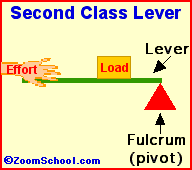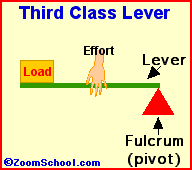I've barely been working at these for two weeks and I'm dumbfounded and stunned as to how fast my calves responded to my GHR work. I'm not doing full-blown GHR's at the moment. I can get about halfway down before I drop and I can push myself up off the ground with my hands. Either way, My calves are really starting to respond. What's going on here? I thought that this was supposed to be the most stubborn muscle to grow?
Well, I was walking around, thinking about my achy calves when it hit me what's going on here...
We all know that the heel raise is the standard method to getting the calves bigger. The trouble is, it works for some people and seemingly not at all for others. The common answer is to add more weight. It's the same situation: for some it works, for others it still doesn't. This is what hit me: it's not that some people aren't adding enough weight. The problem is that their feet have the wrong leverage to make the move work for them!
Note that I didn't say bad leverage. I said WRONG LEVERAGE. Open up any anatomy book and there will be a section discussing the three classes of levers. The heel raising up off the ground is a classic, class 2 lever...


This may not makes sense from here on out unless you do a little reading.
***Disclaimer: I'm not an expert on leverage in relation to the body. I only understand this if I read it and study it enough, over and over and over. I only get what I'm talking about because I experimented and read about it!***
Class 2 levers are more efficient at moving a load if the lever itself is longer. A good example is nail clippers. They're class 2, just like a heel raise. We use toe nail clippers because they are bigger and apply more force to cut through the much-thicker toenail. So, if a person has long feet, relative to their ankles, then the lever is more efficient.
The trouble with that relative to strength training is that the gastrocnemius (calf muscle), in turn, doesn't have to work harder. Remember, muscles only get bigger only when forced to do something really hard. So, good second class lever/long foot equals small calves! This is why women often have more muscular calves than men: smaller feet!

SHOW-OFF!!
Are you with me so far?
So, unless a person with long feet has the capability to pack on some ungodly amounts of weight on a bar, a calf raise is probably not a good exercise for them. So, where do we turn? You guessed it: Change the leverage... ENTER THE GLUTE-HAM RAISE!
We get so caught up in the heel-raising experience of the calf that we neglect it's other job: It also helps flex our knee. Take a look at this picture of the calf muscle...

See how it connects to the femur, above the knee? By doing a GHR, it's not working as a class 2 lever anymore. Now, it's working as the much less efficient class 3 lever (did you read that page like I told you to?) Since it's functioning in a more inefficient manner, it really has to work. More work=more strain=bigger muscle!


The knee joint is the fulcrum, the force comes from the calf muscle's origin at the femur, and the load is the body. Get it?
That isn't to say that the GHR is the only exercise that forces the calf to work as a class 3 lever. Anything that forces it to flex the knee helps. This is why hikers and bicyclists have such muscular calves too!
Sure, it takes some technical reading to understand all of this stuff and I hope I've done a decent job of simplifying it enough for the masses to understand. What I don't get is why on earth this isn't mentioned more often by the people we (half) expect to know this (our trainers, books, etc). Is it ignorance or willfully holding back quality information? I leave it to you to speculate.
In the meantime, I'm going to keep plugging away at the GHR's. It's always nice to see results!
13 comments:
In a calf raise the calf is a 1st class lever, better yet use the classless system;
http://sumoman.co.cc/sumo/articles/2011/lever.html
Completely disagree.
Just because it's so easy to change around placement of the fulcum, load, and force doesn't make classes of levers pointless, just tricky.
The calf muscle isn't a lever at all either, it's the force. The foot is the lever.
Good post, I didn't read the article but got the basic idea of levers (I'm a science student). GHR seems awesome, never heard of it before. I am an ectomorph so I have very small calves and no glutes. It seems like GHR would work your core pretty well too. I think you can easily screw this up or make it less efficient by pushing up with your hands, I think its very important to only let your calves do the work.
TR, there's no way you can let your calves do all of the work on this one! You have to use your hamstrings and glutes too! It's a very hard exercise!
It's effect on the abdominal muscles, I'm not sure to be honest with you. Yes, you have to use them all to keep the body erect. How hard that is probably depends on how strong you are already.
Hi mate,
I would love to pick your brains over email about bodyweight training mate.
for example do you train all body parts everytime or split your workout by bodypart?
If you have an email, i would love to have a chat about it.
Cheers
Andy
Justin,
it's because of insights like these I keep reading your blog.
Genius
Interesting post.I like seeing exercises from biomechanical view.
Just two things that I wanted to point out if it's OK with you.
In heel raises the vertical axis of the force is in the same axis with the load(center of the bodyweight).In that case the force is always equal with the load regardless the length of foot.
That's the case for all three classes of levers when the length of the resistance arm is equal with the effort arm.
Can the calves be considered knee flexors?I believe they're contracting only isometricaly in GHR depending on the way you support your feet.
YOU HAVE TO DO A POST ABOUT JACK LALANNE!!!!!!!!
oops, I erased this from Sumoman by accident...
"Not sure what you are disagreeing with Justin.
If you treat the calf as a 2nd class lever then when you input the figures you will get the wrong answer for calf force. In a calf raise it is claimed that the calf acts as a 2nd class lever but turn it upside down and do a toe press on a vertical leg press with bodyweight and the calf raise is now a 1st class lever... they can't both be correct.
This is because in both cases the calf is a 1st class lever. The only way a calf acts as a 2nd class lever is if the calf's origin were attached to an external object like a wall rather than to its own leg.
As I say... input the figures and treat levers as a classless system whereby all forces and torques balance. If you don't you end up with nonsense figures and a violation of Newton's 3rd law."
Sure they can. All we're talking about when we mention levers is where the load, fulcrum and force are arranged on the lever. That's it! I think this is overcomplicating things terribly.
Douglis,
I thought of this too and I decided to try and set up a two class 2 levers with two differing length levers with 22.5 lbs of load, putting the load in the same spot near the force. The longer lever was slightly, but definetly nociably, easier to lift. I didn't want to blurt this whole blog out without trying it for myself. After all, I'm not able to change feet...
As for the calves flexing isometrically, take a look at where the calf originates: the back of the femur. If the calf flexed isometrically, then it would be trying to stop the knee from bending at all. Muscles do two things: they bring their ends together or gradully let them out. So, if the calf originates at the femur and inserts at the foot, then when they pull together, you get bending at the knee.
I'm working on it now. It's going to be pretty damn blunt too because I'm getting P.O'ed about some of the things I'm hearing...
Running around a lot and jumping on a lot of things helped with size in my calves. Also if I do a one legged squat extending my knee forward as far as I can rather than properly, I feel my calves tighten all around to support the load.
My calves aren't huge, but they're bigger than the average trainee.
If you can do all of the movements you want to do that invovle your calves, why worry about how big they are?
I think people are a bit obsessed with working every single muscle in the body. I dont include you in that justin. I admire your scientific approach to bodyweight training and the sense that you see this type of thing as a mental challenge to overcome.
Sounds a lot like broscience to me.
And those are hamstring curls, not ghr, a common misconception.
Post a Comment